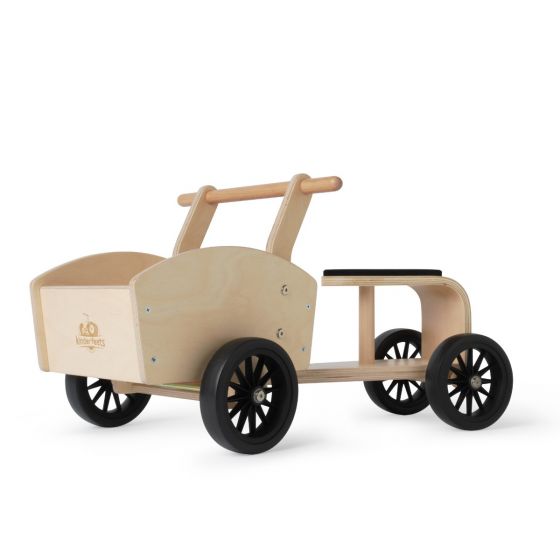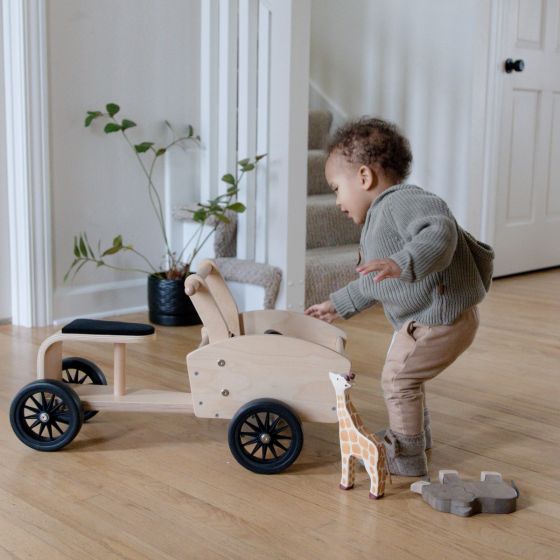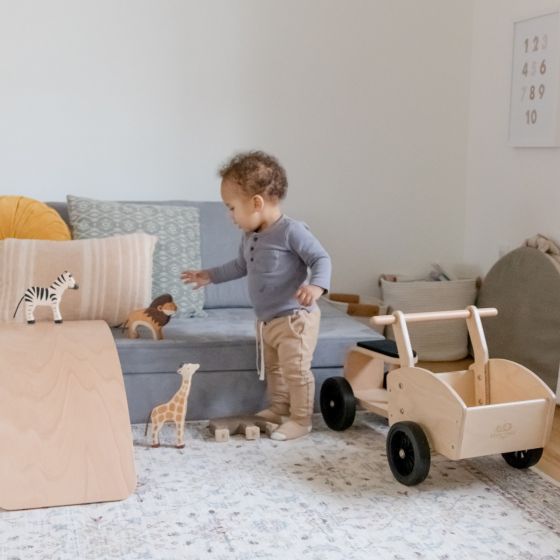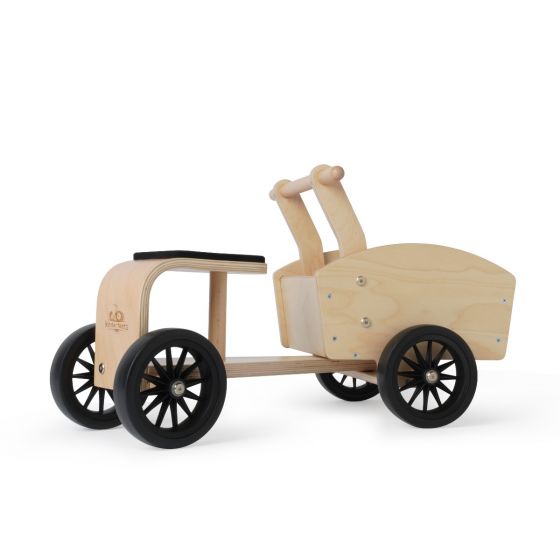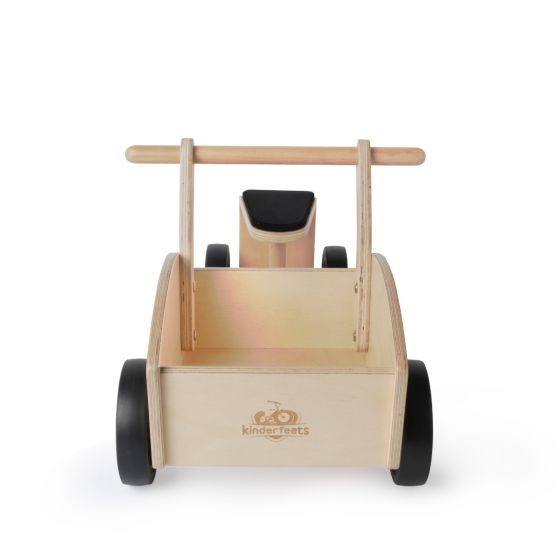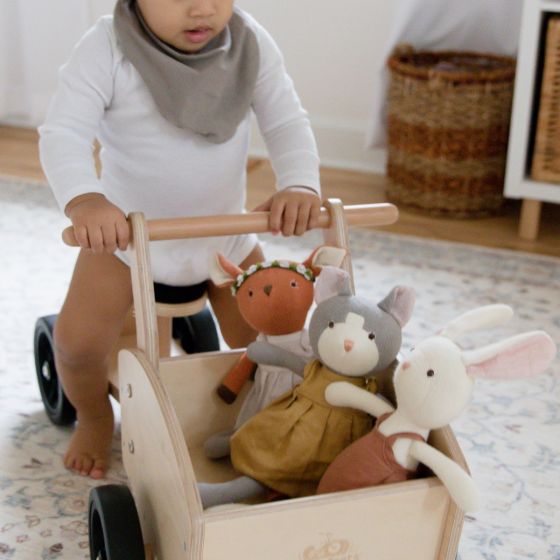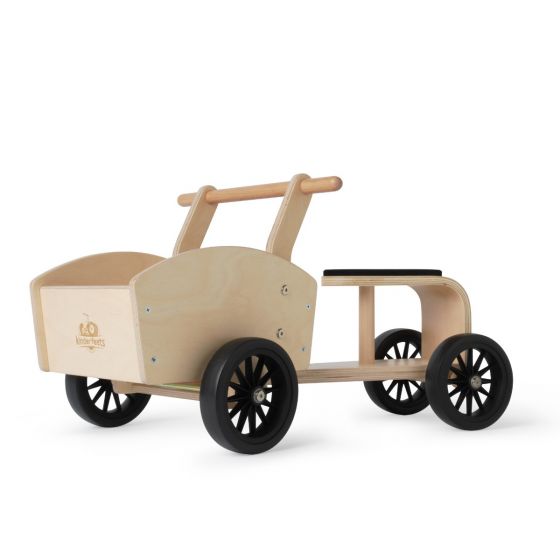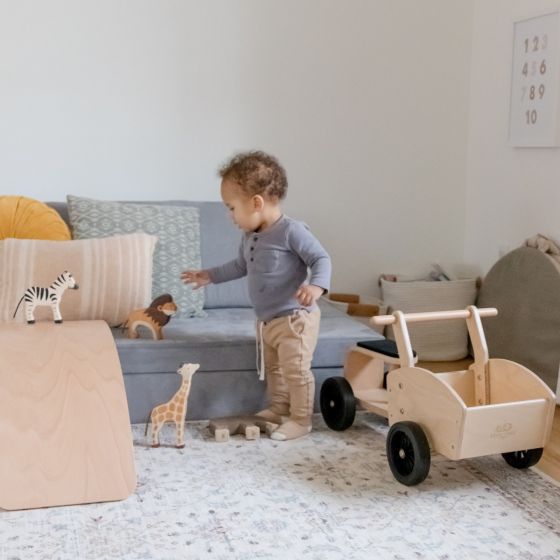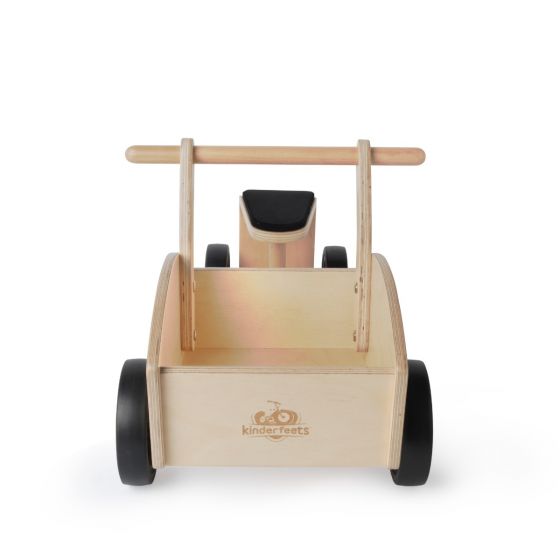Cargo Bike
Cargo Bike
SKU:KF068
Clothing Prem to 18 Months
| Size | Age Guide | Weight | Height |
|---|---|---|---|
| Premature | Premature or Small Newborn | Up to 4Kg | Up to 55cm |
| Newborn | 0-3 months | 4-6Kg | Up to 62cm |
| 3 Month | 3-6 months | 6-8Kg | Up to 68cm |
| 6 Month | 6-12 Month | 8-10Kg | Up to 76cm |
| 12 Month | 12-18 Month | 10-12Kg | Up to 84cm |
| 18 Month | 18-24 Month | 12-14Kg | Up to 92cm |
Clothing 2 to 6 Years
| Size | Age Guide | Height | Chest | Waist | Hip |
|---|---|---|---|---|---|
| 2 Year | 2-3 Years | Up to 100 cm | 56 | 51 | 58 |
| 3 Year | 3-4 Years | Up to 105 cm | 58 | 53 | 60 |
| 4 Year | 4-5 Years | Up to 110 cm | 60 | 55 | 62 |
| 5 Year | 5-6 Years | Up to 115 cm | 62 | 57 | 64 |
| 6 Year | 6-7 Years | Up to 120 cm | 64 | 59 | 66 |
Beanie Size Guide
| Size | Head Circumference | Age Guide |
|---|---|---|
| Premature | 31-35 cm | Premature or Small Newborn |
| Newborn | 35-40 cm | Newborn |
| Small | 40-43 cm | 3-6 Months |
| Medium | 43-47 cm | 6-18 Months |
| Large | 47-52 cm | 18-3 Years |
Sunhat Size Guide
| Size | Head Circumference | Age Guide |
|---|---|---|
| Newborn | 37-40 cm | Newborn |
| Small | 40-43 cm | 3-6 Months |
| Medium | 43-46 cm | 6-12 Months |
| Large | 46-49 cm | 12-24 Months |
| Xtra Large | 49-54 cm | 2-4 Years |
Sleep Pods Size Guide
| Size | Weight | Age Guide | Measurement(Back to Hem) |
|---|---|---|---|
| Newborn | 0-6 kgs | 0-3 Months | 60.5 cm |
| Small | 0-8 kgs | 3-6 Months | 66 cm |
Booties Size Guide
| Size | Age Guide |
|---|---|
| Newborn | 0-3 Months |
| Small | 3-6 Months |
| Medium | 6-12 Months |
| Large | 12-18 Months |
Pretty Brave Baby
| Foot Length (mm) | Insole Length (mm) | EU | UK | Age | INT |
|---|---|---|---|---|---|
| 95-104 | 110 | 16/17 | 2 | 0-6m | S |
| 104-114 | 118 | 18 | 3 | 6-12m | M |
| 114-123 | 127 | 19/20 | 4.5 | 12-18m | L |
| 123-137 | 142 | 21/22 | 5.5 | 16-22m | XL |
Pretty Brave 1st Walker
| Foot Length (mm) | Insole Length (mm) | EU | UK | Age |
|---|---|---|---|---|
| 114-120 | 125-128 | 19 | 3 | 1 yr |
| 120-126 | 132-135 | 20 | 3.5 | 1-2 yrs |
| 126-132 | 138.5-141.5 | 21 | 4.5 | 1-2 yrs |
| 132-138 | 145-148.5 | 22 | 5 | 2 yrs |
Crywolf Swim Nappy
| Size | Length (waist to crotch) | Crotch Width (side to side) |
|---|---|---|
| 0-1 yr | 1-2 yrs | |
| 37 | 38 | |
| 14.5 | 15.5 |
Crywolf Rash Suit
| Size | Length (back neck to crotch) | Chest (arm to arm) | Waist (side to side) | Sleeve (neck to cuff) | Neck Opening(diameter) |
|---|---|---|---|---|---|
| 6-12 Months | 1 yr | 2 yrs | 3 yrs | ||
| 40 | 42 | 44 | 46 | ||
| 25 | 26 | 27 | 28 | ||
| 24 | 25 | 26 | 27 | ||
| 30 | 31.5 | 33 | 34.5 | ||
| 13.25 | 13.25 | 13.8 | 14.3 |
In stock
Couldn't load pickup availability
Overview
Overview
Drawing inspiration from the traditional Dutch Bakfiets, the Kinderfeets Cargo Bike presents a 4-wheel push bike featuring ample front cargo space for toys, trinkets, and cherished companions. Its EVA airless tires ensure surface protection against scratches while ensuring a steady, comfortable journey. Through the physical exertion required to power the bike with their feet, children undergo holistic development, enhancing various aspects of their physical abilities.
Technical Specification
Technical Specification
Delivery and Returns
Delivery and Returns
- Delivery: Free within NZ on orders over $100 (excluding bulky items) or $8 standard shipping
- Returns: Accepted within 14 days of receipt with proof of purchase
- Some items are excluded from returns including sale items, hardware, car seats, prams, monitors and personal items - please click here for the full list.
Share this product
Recently Viewed Products
Related Blogs
Summer smart, right from the start
Keeping little ones safe this summer After a long, cold, virus-heavy winter, many parents will be looking forward to summer – warmer days, fewer illnesses, and time outside with the kids. But after last year’s record-high temperatures, it’s important to remember that summer has dangers too. Babies, with their delicate skin and inability to regulate temperature, are particularly sensitive to harsh sun and heat. Make sure you’re aware and prepared before summer starts, so you can protect your wee ones – no matter how hot it gets. Here’s our summer safety toolkit: Safer with sunscreen Babies and small children have delicate skin that burns easily, so sunscreen is a non-negotiable in the summer months. Even if your children hate the application process, it’s still something that has to be done. If you make it a regular part of their morning routine, they’ll get used to it eventually. • Choose a broad-spectrum sunscreen with SPF30+ at minimum. • Apply sunscreen at least 15 minutes before you go outside, and remember to reapply every 3-4 hours. • Use plenty – apply sunscreen thickly, and don’t miss areas like the back of the arms or ears. • Keep bottles of sunscreen everywhere – the car, the baby bag, grandparents’ house – so you’re never caught without it. • Don’t forget sunscreen on cloudy days – 80% of rays penetrate through cloud cover, so you can still get burnt. Buy the Made 4 Baby SPF50 Natural Sunscreen HERE . Shade solutions Sunscreen is a must if you’re out in the sunshine, but it’s not the only way to prevent sunburn or overheating. Staying indoors or in the shade during the hottest part of the day helps you avoid the heat altogether while dressing appropriately keeps you – and your children – safe and comfortable. • Try to avoid the sun between 11am-4pm, when UV rays are strongest. • Dress your children in loose, dark-coloured or UV-protective clothing and swimwear – the sun’s rays can penetrate light, thin fabrics. • Choose long-sleeved swimwear. • Make sure your babies and children always wear hats – full brim is best. • Use a sunshade or cover for your pram – but make sure it’s not preventing airflow to your baby, or she could overheat. • Use a shade cloth or stick-on shade in the car, to keep your baby’s seat out of the sun. Check out our range of Cotton Products Here Overheating and hydration During the summer months, it’s important to keep babies and children hydrated and cool as much as possible. Because they’re less developed than adults, babies and small children can’t regulate their body temperature properly, which means they’re more susceptible to overheating. During record high temperatures, overheating and dehydration can be a real concern for smaller babies. Although it’s less common in New Zealand’s fairly temperate climate, babies have died of heat exhaustion in extreme weather • Keep small children indoors, preferably with air conditioning on, during very high temperatures. • Make sure children drink plenty of fluids – homemade ice-blocks are a great way to get more liquid into them. • Give breastfed babies more frequent feeds – your milk will naturally be less concentrated to keep your baby hydrated. Drink more water yourself. • Bottle-fed babies should also be given more feeds – you can offer small amounts of water if you’re concerned about dehydration. • Dress babies and children lightly for sleep, and use a fan or air conditioning to keep the temperature in their room down. • Never leave a baby or child alone in the car, as temperatures can rise extremely rapidly. • If your baby or child is showing signs of dehydration or heatstroke – including lethargy, a dry mouth, fewer wet nappies, or a sunken fontanelle – seek medical treatment immediately. If it all sounds a bit alarming, don’t worry. Summer should be a time of fun and relaxation, even when you do have small children. As long as you’re aware and well prepared, you – and your wee ones – should be fine. Don't Forget the Sunscreen! Buy Sun Lotion Here
Learn moreEncouraging play time with your little one
Encouraging play time with your little one Playtime with your children is one of the most powerful ways to contribute to your child’s development. It is so important to have these playful interactions with your little one early on in the Newborn stage. To build a connection between you and your Newborn this form of interaction doesn’t require much more than using your face, voice and body to keep them entertained. You will begin to learn more about one another and start to see you baby’s personality come to light. You may feel in the beginning as if this form of play is a little one sided, however through these interactions you are helping with their cognitive and sensory development. They are beginning to build connections in their brains which will help them to understand different words. Beginning by making funny faces and smiling, singing, telling nursery rhymes, and reading to them are all the simplest and most effective ways to interact with baby. Introducing your baby to new materials that they can touch and move around is another great way to stimulate their brains. Allowing them to do things as simple splashing around water during bath time is a great way of helping them to explore their senses. During these early stages of development you are the most important tool for your baby’s entertainment however Dimples also sells a range of interactive toys in various forms to aide when it comes to play time between you and your little one. Toys to add when it is play time. The Jelly Cat books follow delightful little characters through a variety of different stories. Story time with your little one is a great way to interact and stimulate their mind. Changing the pitch and tone of your voice will help with baby making different connections in their brain. Play time can require a lot of energy for baby so you will notice they can quickly get tired. Baby will signal they are getting tired by looking away from you, they may become disinterested or even grumpy. After your baby is rested, they will signal when they are ready to play again by looking towards you, making noises as well was wiggling their arms and legs about. Evolving play time as your child grows As baby grows up, they are learning more every day. They are beginning to develop new skills therefore it is important to evolve your playtime routine. Between the ages of one and two your toddler will begin to explore the world and will begin to gain more of an idea on how things work. During this age it is great to have a balance between structured and unstructured play. Unstructured play is allowing your child to explore what strikes their own interest. It is through unstructured play where you will learn the most about your child and what they are attracted to. Here it is best to take a step back and watch your little one’s imagination grow. Structured play is a great way for you child to learn in a more organised setting, this may involve activities such as swim lessons, musical groups, dance classes. Structured play will help to broaden your toddler’s knowledge and physical skills, this often takes part within a group setting. Play within a social setting is important as it helps to develop social and communication skills as well as teach them about sharing. It is a good idea when buying toys to keep you little one entertained to consider buying toys that are educational, therefore you are ensuring that not only are they having fun but they are also expanding their knowledge. Dimples offers a range of educational yet entertaining toys to make sure you little one’s mind is always learning. The Stacking Ring Tower from Mushie is made from 100% non-toxic BPA and phthalate free plastics, they help to refine bubs organisational and motor skill all while being fun for them to play and engage with. Screen time is an important factor to be aware of. Putting your child in front of a screen is an easy solution when needing to keep your little one entertained so you can get certain tasks done. However, it important to consider balance when it comes to how much screen time you are allowing you child to have. Screens only show a two-dimensional world, it doesn’t offer the same sensory experience that you child will gain when they are out and about. Play time away from the screen allows your child to explore all five senses and use their imagination, you will notice their knowledge broadening quickly the more they venture into the world.
Learn moreThe Play Table Packed with Possibilities
Harness the power of early learning with the Stokke® MuTable that grows and adapts just as quickly as your child’s imagination! Play isn’t just fun – it’s also the foundation of learning. A children’s play table gives little ones the perfect space to explore with both hands and minds. From building the MuTable Play House (which comes complete with dolls and toys) to tackling puzzles or inventing animal adventures with play dough, every activity sparks creativity, problem solving, and growth. The MuTable is designed to grow with your child. It comes with three double sided activity boards, each one offering new adventures and challenges as your little one develops. From quiet solo play to lively group fun, there’s something to spark curiosity at every stage: A wooden cover that flips to become a blackboard for doodles, scribbles, and first masterpieces A reversible landscape board featuring a peaceful nature setting on one side and a bustling city scene on the other A bricks board with surfaces for both small and large blocks, giving building projects endless possibilities The MuTable chairs are perfectly sized for little ones to sit comfortably while they draw, build, and create. Cleverly designed to grow with your child, the seat height can be adjusted as they get bigger. When it’s time for a change, simply remove the backrest and the chair transforms into a sturdy stool that can hold up to 100kg. Why a child’s play table is a game changer A fun zone for kidsA child-sized play table and chair set creates a safe, comfortable space just for them. It encourages proper posture while giving little ones their very own place to play, build, and create. Nurtures creativityFrom drawing and painting to building towers or sculpting playdough, a play table becomes the stage for endless adventures. With the MuTable’s colourful, tactile boards, your child can dive into imaginative worlds every day... saving the city, exploring nature, or inventing their own stories. Encourages independenceEasy access to their own table and chairs means children can jump into play whenever they choose. This sense of ownership helps build problem-solving skills, self-sufficiency, and confidence. Brings kids togetherA play table is also a hub for teamwork. Kids can play side by side, sharing space while still enjoying their own chair. This is perfect for collaboration, cooperation, and making memories. Made to lastCrafted from premium natural wood, the MuTable and chairs are built for years of use, backed by a 3-year warranty. Softly curved edges ensure safety, while the award-winning design blends seamlessly with any home. Grows with your childDesigned to adapt as your little one gets older, both the table and chairs come with leg extensions to raise the height as needed. The clever design means the MuTable keeps up with every stage of childhood.
Learn moreIntroducing a bedtime routine with your baby
The Power of a Bedtime Routine for Your BabySimple rhythms that lead to better sleep - for both of you In the early weeks with a newborn, life tends to move to a rhythm all on its own. Feeds, naps, cuddles, and nappy changes often blur into one another, and any sense of routine can feel a little out of reach. That’s completely normal! As your baby grows, you’ll notice more predictable patterns beginning to emerge. This is the perfect time to gently introduce a bedtime routine – a simple series of calming steps that helps your baby unwind and gives you both a peaceful finish to the day. Why bedtime routines matter Babies thrive on repetition. A consistent series of calming activities each evening helps regulate their body clock, encourages longer stretches of sleep, and creates a comforting rhythm to the day. Routines don’t just benefit sleep - they also nurture connection, ease overstimulation, and make bedtime feel less like a battle and more like a shared moment of calm. These rituals will evolve as your baby grows, but the sense of structure and predictability will continue to support their development well into childhood. When to begin You can begin easing into a bedtime routine from around six to eight weeks old - once your baby begins to show more consistent sleep and feeding patterns. This is also when they start to recognise daily cues, making it the perfect time to introduce a gentle ritual that helps them wind down. How to get started There’s no “perfect” routine - what works for one family might not suit another. The key is consistency, calmness, and keeping things relatively short (20 to 30 minutes is ideal). Try to carry out most of the routine in your baby’s room so they start to associate the space with sleep. Here’s a sample rhythm to get you started: Bath - A warm bath helps wash away the day and begins the wind-down process. This can also be a fun and playful moment, especially if older siblings are involved. Massage - After bath time, a quick massage with something like Scullys Baby Massage Oil can help your baby get ready for rest. This is a wonderful way to connect with your baby through touch, as well as being very relaxing for both of you. Sleepwear - Soft, breathable pyjamas or a sleeping gown signal that bedtime is near. You might like to use Merino to help regulate temperature throughout the night. We have a gorgeous range of safe and cosy sleepwear available here. Feeding - Try offering the final feed early in the routine rather than just before sleep. This can help reduce reliance on feeding to fall asleep. Story or song - A simple board book, soft lullaby, or even humming a tune gives your baby a consistent cue that bedtime is here. It also builds language skills and creates special bonding moments. Cuddles - A warm snuggle and quiet kiss goodnight helps your baby feel safe, even if you’ll likely see them again overnight. Watch for sleepy cues Rather than watching the clock, keep an eye on your baby. Rubbing eyes, zoning out, yawning, or fussing can all signal tiredness. Aim to start the bedtime routine before they become overtired. For most babies, somewhere between 6:30 and 7:30 pm works well, and this timing can continue into the early school years. Keep the environment sleep-friendly A dark, quiet space tells your baby’s brain that it’s time to sleep. Avoid bright lights, noisy toys, or too much stimulation. Night lights can be helpful for feeding and changes, but aren’t necessary for sleep - babies aren’t born afraid of the dark. You could add a soft and practical sleep sound machine, like a Yogasleep Nod to make night-time care easier with it's built in night light. Put baby to bed drowsy, not asleep As you get to know your baby’s cues, try placing them into bed when they’re sleepy but still awake. This helps them learn to settle themselves, which can make overnight waking easier to manage. It also reduces the shock of waking up in a different spot from where they fell asleep. Be consistent - but stay flexible Consistency is key, but so is flexibility. There’ll be times when travel, illness, or overtired evenings throw things off. The idea is to have a calming, repeatable routine you can come back to, wherever you are. If more than one caregiver can do bedtime, that helps too - it builds flexibility and avoids babies becoming dependent on one specific parent for settling. Small rituals with lasting benefits Your baby’s routine doesn’t need to be perfect, and it will change over time. But these small, daily rhythms bring more than just sleep - they offer connection, confidence, and a peaceful way to end the day together. One day, your baby will be reading their own book at bedtime. But your cuddle and goodnight kiss? That will still matter, even if you have to sneak it in after lights out ❤️
Learn more

